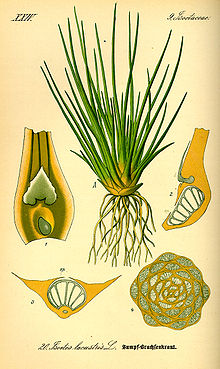
Back إسويطيات Arabic İzoetçiçəklilər Azerbaijani Isoetals Catalan Brasenføde-ordenen Danish Brachsenkrautartige German Izoetaloj Esperanto Lahnarohulaadsed Estonian شهپرعلفسانان Persian Isoetales French Isoetales Croatian
| Isoetales | |
|---|---|

| |
| Isoetes | |

| |
| Pleuromeia | |
| Scientific classification | |
| Kingdom: | Plantae |
| Clade: | Tracheophytes |
| Clade: | Lycophytes |
| Class: | Lycopodiopsida |
| Order: | Isoetales Prantl |
| Families | |
|
Chaloneriaceae† | |
Isoetales, sometimes also written Isoëtales, is an order of plants in the class Lycopodiopsida.
There are about 140-150 living species, all of which are classified in the genus Isoetes (quillworts), with a cosmopolitan distribution, but often scarce to rare. Living species are mostly aquatic or semi-aquatic, and are found in clear ponds and slowly moving streams. Each leaf is slender and broadens downward to a swollen base up to 5 mm wide where the leaves attach in clusters to a bulb-like, underground corm characteristic of most quillworts. This swollen base also contains male and female sporangia, protected by a thin, transparent covering (velum), which is used diagnostically to help identify quillwort species. Quillwort species are very difficult to distinguish by general appearance. The best way to identify them is by examining the megaspores under a microscope.
Isoetes are the only living pteridophytes capable of secondary growth.[1]
- ^ Karrfalt, Eric E. (1982-12-01). "Secondary Development in the Cortex of Isoetes". Botanical Gazette. 143 (4): 439–445. doi:10.1086/337319. ISSN 0006-8071. S2CID 84969975.
© MMXXIII Rich X Search. We shall prevail. All rights reserved. Rich X Search